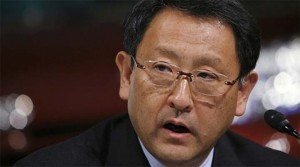
Toyota expects to make up much of its lost production of vehicles like the RAV-4 during the second half of its current fiscal year.
Toyota’s balance sheet will take a significant hit as a result of the earthquake and tsunami that struck Northeast Japan earlier this year, the disaster now forecast to reduce the maker’s profits by 35% for the current fiscal year.
The maker’s operating profit is expected to slip to 300 billion yen, or $3.7 billion at the anticipated exchange rate of 82 yen to the dollar – which is also significantly lower than the consensus forecast of 434 billion yen anticipated by 23 analysts surveyed by Thomson Reuters. But Toyota officials now say they also anticipate a faster recovery than first feared, with production during the second half of the fiscal year, which began on April 1, running substantially higher than originally planned.
“We will enter a phase of production make-up and recovery and will make up for lost production to the tune of 350,000 units,” said Senior Managing Director Takahiko Ijichi, during a conference call this morning, “so the overall unit production decrease would be 450,000 units” for the full fiscal year.
The executive told industry analysts and reporters that about 60% of the impact from the March 11 disaster will be felt overseas, “primarily in the United States.” The maker notably suffered a sharp drop in sales and a 10% decline in its U.S. market share in May, which Ijichi insisted was almost solely the result of product shortages – and Toyota’s subsequent decision to sharply trim its incentives and marketing programs.
In fact, those cost-saving measures will actually reduce Toyota’s losses from the quake, he suggested, though the maker’s bottom line is feeling the pinch from other headwinds. These include both rising raw materials prices, which will cost it about 40 billion yen more than originally expected this year. And then there’s the yen, the current exchange rate off from about 86 yen to the dollar last year.
That’s an especially serious problem for Toyota, which produces nearly half of it global output in the home market, almost twice as much as key competitors Honda and Nissan.
“We are in a situation where it’s becoming impossible for Japan’s manufacturing industry to do business,” said Toyota Chief Financial Officer Satoshi Ozawa, during a separate Tokyo briefing on the maker’s forecast.
The earnings forecast came almost exactly a month after Toyota CEO Akio Toyoda revealed a 77% decline in first-quarter earnings, which plunged to 25.4 billion yen, or $314 million, compared with 112.2 billion yen during the year-before quarter. While the earthquake cost about 110 billion yen, Toyoda noted that the lopsided exchange rate had nearly triple the impact, reducing Toyota’s net by 290 billion yen, or $3.6 billion.
Long a key proponent for maintaining home market production, even Toyoda had to admit that was becoming a more difficult argument to make, cautioning that, “I fully understand that we can’t go on with just a desire to protect manufacturing in Japan.”
The likelihood that things will improve significantly in the second half – with Toyota expanding all plants to be operating at normal levels, many working overtime, by November – was buoyed by the faster-than-anticipated recovery of key suppliers, such as Renesas, the producer of about a quarter of the world’s automotive microchips. It has resumed production and expects to be fully operational by September, a month earlier than feared.
During his conference call, Managing Director Ijichi predicted Toyota will be able to fully recover its sales and share in the critical American market, Toyota’s single largest profit center during better times. ith the maker already starting to rebuild its inventory, he said, “We’re at a time when we will use incentives more actively than before.”
Ijichi said he is particularly optimistic because of the upcoming launch of the Prius Alpha, the second model in Toyota’s new hybrid brand-within-a-brand. Sharing a badge with the older Prius, the new model will be dubbed Prius V in the States. Earlier this week, Toyota announced preliminary dealer orders for the new hybrid are running ahead of expectations, prompting a push to increase production. (For more, Click Here.)
Perhaps, but overall hybrid sales in the U.S. have begun to slip, despite near-record fuel prices and, as TheDetroitBureau.com reported, that dip seems to reflect more than just the shortage of key products, such as the Toyota Prius. (Click Here for that story.)
Meanwhile, despite the optimism of Toyota executives, industry analysts warn that the maker could have a tougher time than it anticipates rebuilding demand in the U.S. Its quake-related problems struck at a particularly bad time, with key competitors launching new products, such as the Ford Focus and Hyundai Elantra, aimed at picking up Toyota’s lost share – and hanging onto it.
Ford this week announced it will launch its new C-Max microvan as a hybrid-only model, global marketing chief Jim Farley calling it Ford’s “Prius fighter.”
On the other hand, Prius remains, even after the quake, the world’s best-selling hybrid-electric vehicle, a lead Toyota remains determined not to yield.

